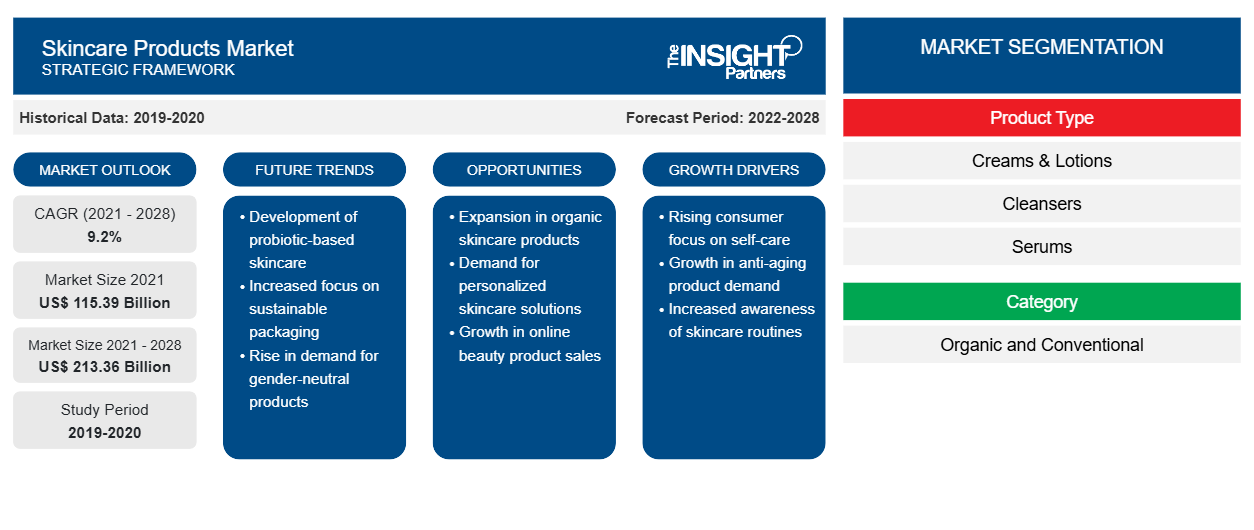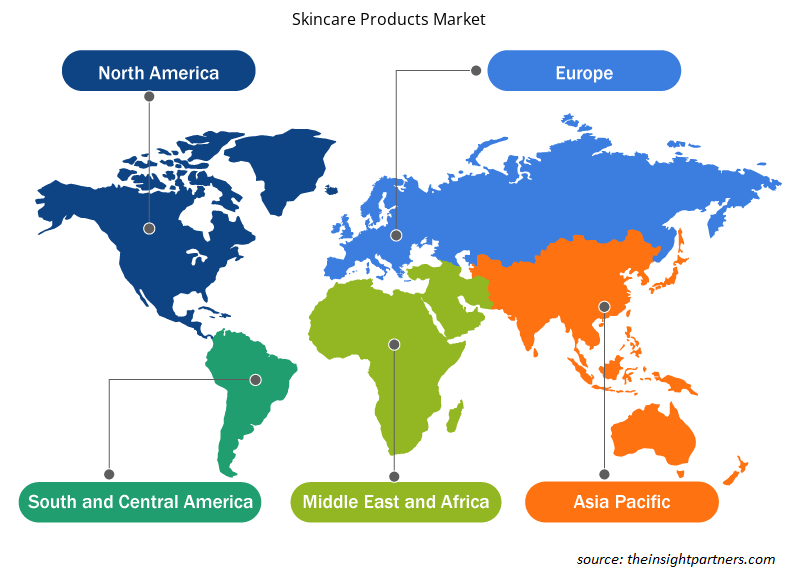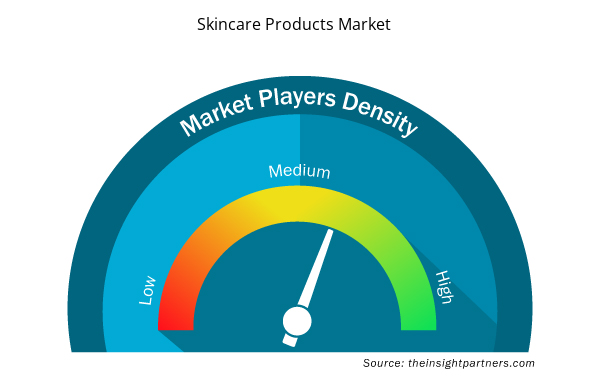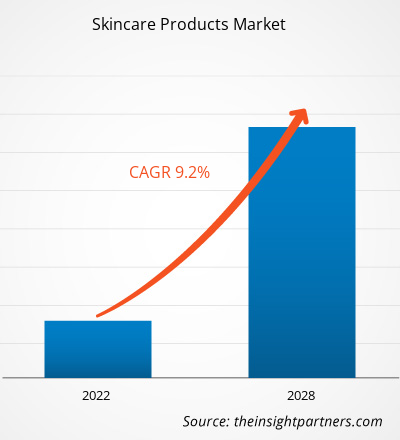The skincare products market size was valued at US$ 115,386.46 million in 2021 and is projected to reach US$ 213,363.09 million by 2028. It is expected to grow at a CAGR of 9.2% from 2021 to 2028.
Skincare products are a range of products that help maintain skin integrity, improve attractiveness, and relieve skin disorders. These are applied to the skin to prevent premature aging, acne, and black patches. Skincare products include creams, lotions, and powders that nourish and improve the quality of the skin. These products are used regularly by both men and women for various purposes, such as moisturizing, hydrating, and cleansing. Organic and herbal skincare products have been popular in recent years. This is because people are aware of the harmful effects of synthetic chemicals on the skin. Ingredients originating from natural sources, such as leaf extracts and root extracts, are safe for the skin because they have no harmful effects.
Asia Pacific held the largest share of the global skincare products market in 2020 and is expected to grow significantly over the forecast period. Asia Pacific is one of the largest personal care and beauty products markets. People in the region heavily focus on skin care and prefer products that improve the skin. Skincare products are believed to enhance skin strength and elasticity and enhance the appearance of dry and damaged skin, making the skin soft, supple, and wrinkle-free. Thus, the growth of the personal care industry in the region and increase in demand for products that provide functional benefits to the skin are the key factors driving the skincare products market across Asia Pacific.
Customize This Report To Suit Your Requirement
You will get customization on any report - free of charge - including parts of this report, or country-level analysis, Excel Data pack, as well as avail great offers and discounts for start-ups & universities
Skincare Products Market: Strategic Insights

- Get Top Key Market Trends of this report.This FREE sample will include data analysis, ranging from market trends to estimates and forecasts.
Customize This Report To Suit Your Requirement
You will get customization on any report - free of charge - including parts of this report, or country-level analysis, Excel Data pack, as well as avail great offers and discounts for start-ups & universities
Skincare Products Market: Strategic Insights

- Get Top Key Market Trends of this report.This FREE sample will include data analysis, ranging from market trends to estimates and forecasts.
Impact of COVID-19 Pandemic on Skincare Products Market
The COVID-19 pandemic affected many industries due to nationwide lockdowns, business shutdowns, and supply chain disruptions. There was a mixed impact of the pandemic on the skincare products market. Initially, due to lockdowns and business shutdowns, manufacturers suffered from a shortage of raw materials and labor, which affected their production and supply.
Furthermore, many nations are vaccinated, and governments have relaxed the restrictions imposed on manufacturing and trade. These factors are expected to drive the skincare products market over the forecast period. Thus, the COVID-19 pandemic significantly impacted the skincare products market.
Market Insights
Growing Consumption of Antiaging Products
Growing Consumption of Antiaging Products
The growing consciousness among both the young and old consumers regarding their physical appearance has fostered the demand for anti-aging skincare products. Rising awareness among consumers about age-related skin problems such as fine lines, wrinkles, and dull skin, coupled with an increased susceptibility to spend on products that help them demonstrate their skin youthfulness, is expected to drive the market. Anti-aging creams and lotions play an essential role in an individual's life by assisting in preserving a youthful glow and moisturization. Some specially formulated products help the facial skin retain moisture, firmness, and elasticity, thus, preventing wrinkles and lines. People are highly concerned about their facial appearance and do not shy away from spending exorbitantly on such products, which is a key factor driving the segment.
Furthermore, with the growing concerns over animal welfare and the environment, several consumers are choosing cruelty-free products, which has increased the demand for vegan or plant-based ingredient fuse in skincare products. New product launches and innovations are expected to drive the market. For instance, in January 2019, Drunk Elephant launched A-Passioni vegan anti-wrinkle cream with vegan and gluten-free ingredients that restore the skin for a youthful look. Although the anti-aging products have normally been distributed by departmental stores, specialty stores have made them more reachable and widely available. These products are also being sold through online stores, salons, spas, specialty retail shops, and direct response television such as infomercials and home shopping channels.
Product Type Insights
Based on product type, the skincare products market is segmented into creams and lotions, cleansers, serums, and others. The creams and lotions segment held the largest share of the global skincare products market during the forecast period. Lotions and creams are skincare products used to keep the skin moisturized. Both products are made with a combination of oil and water. However, there is a difference in oil and water content percentages. In lotions, oil droplets are mixed in the water, and in creams, water droplets are mixed in oil.
Moreover, creams are used for various purposes, such as tan removal, brightening, oil reduction, dark circle removal, and acne removal. Lotions are used for nourishing the skin and preventing sunburns and tanning. Thus, both products have gained significant traction among users and are expected to boost the market growth for the segment during the forecast period.
Category Insights
Based on category, the skincare products market is segmented into organic and conventional. The conventional segment held a larger share in the global skincare products market over the forecast period. Conventional skincare products often consist of synthetic substances such as parabens, triclosan, formaldehyde, and phenoxyethanol. They are potentially irritating and allergenic components developed in a lab. Synthetic chemicals are hazardous to human skin, animals, and plants. Furthermore, the production of traditional skincare products emits a large amount of pollution, leaving a negative carbon footprint on the earth, thereby hindering the segment's growth. However, the easy availability and low cost of conventional skincare products are boosting the skincare products market growth.
Distribution Channel Insights
Based on distribution channel, the skincare products market is segmented into supermarkets and hypermarkets, specialty stores, online retail, and others. The online retail segment is projected to grow at the fastest CAGR during the forecast period. Online retail is one of the fastest-growing distribution channels due to its shopping and product delivery convenience. Online retail stores offer a wide range of products and heavy discounts. Also, consumers can conveniently buy desirable products remotely. Additionally, home delivery service attracts many consumers to shop through e-commerce portals. Moreover, these websites offer comprehensive product information and user reviews, which help buyers compare products and make informed decisions. During the COVID-19 pandemic, online retail channels gained popularity as they offered home delivery services. This factor is expected to boost the skincare products market growth for the online retail segment in the near future.
Skincare Products Market Regional Insights
Skincare Products Market Regional Insights
The regional trends and factors influencing the Skincare Products Market throughout the forecast period have been thoroughly explained by the analysts at Insight Partners. This section also discusses Skincare Products Market segments and geography across North America, Europe, Asia Pacific, Middle East and Africa, and South and Central America.

- Get the Regional Specific Data for Skincare Products Market
Skincare Products Market Report Scope
| Report Attribute | Details |
|---|---|
| Market size in 2021 | US$ 115.39 Billion |
| Market Size by 2028 | US$ 213.36 Billion |
| Global CAGR (2021 - 2028) | 9.2% |
| Historical Data | 2019-2020 |
| Forecast period | 2022-2028 |
| Segments Covered |
By Product Type
|
| Regions and Countries Covered | North America
|
| Market leaders and key company profiles |
Skincare Products Market Players Density: Understanding Its Impact on Business Dynamics
The Skincare Products Market market is growing rapidly, driven by increasing end-user demand due to factors such as evolving consumer preferences, technological advancements, and greater awareness of the product's benefits. As demand rises, businesses are expanding their offerings, innovating to meet consumer needs, and capitalizing on emerging trends, which further fuels market growth.
Market players density refers to the distribution of firms or companies operating within a particular market or industry. It indicates how many competitors (market players) are present in a given market space relative to its size or total market value.
Major Companies operating in the Skincare Products Market are:
- L
Disclaimer: The companies listed above are not ranked in any particular order.

- Get the Skincare Products Market top key players overview
End-User Insights
Based on end-user, the skincare products market is segmented into men, women, and others. The men segment is projected to grow at the fastest CAGR in the global skincare products market over the forecast period. The rising awareness among the male population about good hygiene and regular grooming, increasing product launches, surging celebrity endorsements, and growing disposable income are among the factors boosting the growth of the skincare products market for the men segment. In addition, the willingness to achieve better physical appearance and growth in per capita income are anticipated to bolster the sales of personal care products among the male populace, which is further expected to support the market growth during the forecast period.
The key players operating in the skincare products market include L'Oréal Groupe; Beiersdorf; Shiseido CO., LTD.; Procter and Gamble; Unilever; Himalaya Wellness Company; Lotus Herbals; VLCC Wellness; Avon Products; and Johnson and Johnson Services, Inc. These players are engaged in developing innovative products to meet the emerging consumer trends. Moreover, they are involved in mergers & acquisitions, business expansion, and partnerships to expand their market share globally.
Report Spotlights
- Progressive industry trends in the skincare products market to help players develop effective long-term strategies
- Business growth strategies adopted by developed and developing markets
- Quantitative analysis of the skincare products market from 2019 to 2028
- Estimation of global demand for skincare products
- Porter's five forces analysis to illustrate the efficacy of buyers and suppliers operating in the industry
- Recent developments to understand the competitive market scenario
- Market trends and outlook as well as factors driving and restraining the growth of the skincare products market
- Assistance in the decision-making process by highlighting market strategies that underpin commercial interest, leading to the skincare products market growth
- The skincare products market size at various nodes
- Detailed overview and segmentation of the market, as well as the skincare products industry dynamics
- Size of the skincare products market in various regions with promising growth opportunities
- Historical Analysis (2 Years), Base Year, Forecast (7 Years) with CAGR
- PEST and SWOT Analysis
- Market Size Value / Volume - Global, Regional, Country
- Industry and Competitive Landscape
- Excel Dataset



Report Coverage
Revenue forecast, Company Analysis, Industry landscape, Growth factors, and Trends

Segment Covered
Product Type, Category, End User, and Distribution Channel

Regional Scope
North America, Europe, Asia Pacific, Middle East & Africa, South & Central America

Country Scope
Argentina, Australia, Brazil, Canada, China, France, Germany, India, Italy, Japan, Mexico, Russian Federation, Saudi Arabia, South Africa, South Korea, United Arab Emirates, United Kingdom, United States
Frequently Asked Questions
Based on category, the conventional segment held the largest market share in 2020. Since conventional skin care products are less expensive, there is a greater demand for them on the market, and they also have a longer shelf life than organic skin care products.
Based on end users, the women segment held the largest market share in 2020. Skin care products of various types have become increasingly popular among beauty salons, entertainment sector and various type of events. Because of their simplicity of use, these skin care products are already being embraced commercially on a big basis.
People have become more conscious of personal care items as their living conditions improved as a result of rapid urbanization and a rise in the working population. Many people are more inclined to utilize skin care and body care items when their disposable earnings and spending capacity rise. Consumers like skin care items such as face wash, cleansers, moisturizers, lotions, masks, serums, sunscreens, gels, and body care products. Due to rising customer demand, manufacturers in the global skin care products market are expanding their product development capability. The market's expansion is being fueled by the lucrative presence of small and medium-scale producers that are developing novel products.
In 2020, Asia-Pacific held the largest share in the global skin care products market. The rising adoption of skin care products with the increasing demand for creams and lotions, cleansers, serums, and other products are the key factors driving the market growth.
Based on product type, the creams and lotions segment is projected to grow at the fastest CAGR over the forecast period owing to the growing demand for high-quality.
The major players operating in the global skin care products market are L’Oreal Groupe, Shiseido Co., Procter & Gamble, Unilever, Avon Products, Johnson and Johnson Services, Inc among others.
Trends and growth analysis reports related to Consumer Goods : READ MORE..
The List of Company - Skincare Products Market
- L’Oréal Groupe
- Beiersdorf
- Shiseido Co.,Ltd.
- Himalaya Wellness Company
- Procter & Gamble
- Unilever
- LOTUS HERBALS
- VLCC Wellness
- AVON PRODUCTS
- Johnson & Johnson Services, Inc.

 Get Free Sample For
Get Free Sample For